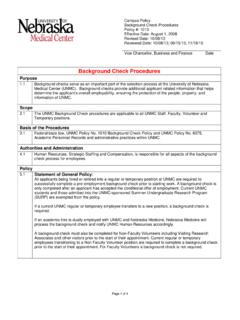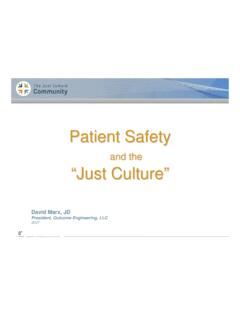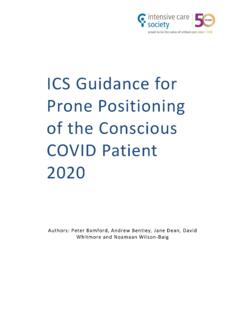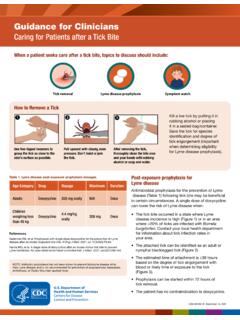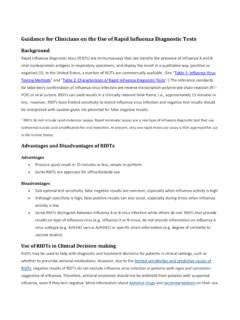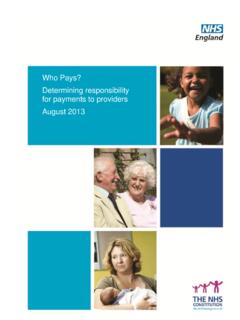Transcription of Antibiotic Guidance for Treatment of Acute Exacerbations ...
1 Antibiotic Guidance for Treatment of Acute Exacerbations of COPD (AECOPD) in Adults Antibiotics are not recommended for all patients with AECOPD as bacterial infection is implicated in less than one-third of AECOPD. Procalcitonin (PCT) may be helpful in determining if antibiotics are necessary or the duration of Treatment . All Antibiotic dosages listed below are based on normal renal and hepatic function. The typical duration of therapy for AECOPD is 5 days. Antibiotics should only be started or continued in patients with signs and symptoms of a bacterial infection that include the following: 1) Increased dyspnea, increased purulence of sputum, and increased volume of sputum OR 2) Ventilator support (invasive or non-invasive) for AECOPD Patients with a PCT < ng/mL are unlikely to benefit from Antibiotic administration Mild exacerbation (no respiratory failure+, FEV1 >50% predicted, < 3 Exacerbations /year) o 1st line.
2 Doxycycline 100 mg PO BID OR Cefuroxime 500 mg PO BID o 2nd line: Azithromycin 500 mg PO daily* Moderate exacerbation (non-life-threatening respiratory failure+, FEV1 36-50%, 3 Exacerbations /year, 65 years of age) o 1st line: Amoxicillin-clavulanate 875-125 mg PO BID OR Doxycycline 100 mg PO BID o 2nd line: Azithromycin 500 mg PO daily* Severe exacerbation (life-threatening respiratory failure+, baseline FEV1 35%) OR Requires ventilator support: o No risk factors for Pseudomonas aeruginosa: Ceftriaxone 1 gram IV every 24 hours (>80 kg: Ceftriaxone 2 grams IV every 24 hours) Severe beta-lactam allergy: Levofloxacin 750 mg PO or IV every 24 hours** o Risk factors for Pseudomonas aeruginosa (see Table 1): 1st line: Cefepime 1 gram IV every 6 hours 2nd line: Piperacillin-tazobactam grams IV every 8 hours Severe beta-lactam allergy: Aztreonam 2 grams IV every 8 hours + levofloxacin 750 mg po or IV every 24 hours** + Respiratory status adapted from the 2018 GOLD guidelines.
3 See Table 1. For patients with re-admission within 30 days or recurrent AECOPD, consider expert consultation with a pulmonologist. * Consider ECG prior to initiating, especially if other QTc-prolonging medications are present. Alternate therapy may need to be considered in patients at high risk of cardiovascular events. ** As of July 2016, the FDA no longer recommends fluoroquinolones for the Treatment of Acute Exacerbations of bronchitis. This therapy should be reserved for severe beta-lactam allergy where no other Treatment options are available.
4 Current labeling includes a black box warning for CNS effects, tendonitis or tendon rupture, and peripheral neuropathy that may be irreversible. Consider ECG prior to initiating, especially in patients with other QTc-prolonging medications. Chronic Obstructive Pulmonary Disease Pathway PURPOSE: To provide a framework for the initial evaluation and management of patients admitted with Acute Exacerbations of chronic obstructive pulmonary disease (COPD) based on recent literature and guidelines. Appropriate management of these Exacerbations can have a significant impact on the patient s morbidity and mortality; therefore, it is important that evidence-based regimens are utilized in these patients.
5 Antibiotics are often used in Acute Exacerbations of COPD (AECOPD) as bacteria are commonly implicated in these patients; however, Exacerbations may be caused by viruses and other environmental factors. This document will provide the clinician with Guidance to assist with diagnosis and management of AECOPD. COPD order sets are available within One Chart and contain much of the information below. These order sets should be utilized as they provide a convenient way to provide evidence-based care to patients at Nebraska Medicine.
6 DEFINITION1: Chronic Obstructive Pulmonary Disease (COPD) is a progressive respiratory disease characterized by inflammation and structural changes leading to decreased airflow. The most common symptoms of COPD include chronic cough, dyspnea, and sputum production. The disease includes emphysema and obstructive bronchiolitis. Chronic bronchitis may be present in patients with COPD, but it is considered to be a separate disease state. COPD affects millions of patients in the United States and Exacerbations account for a significant proportion of healthcare expenditures each year.
7 Acute Exacerbation of COPD (AECOPD) is defined as a sudden worsening of the patient s symptoms requiring medical intervention. AECOPD can have a significant impact on the patient s prognosis and mortality. Exacerbations requiring hospitalization have a risk of mortality of approximately 10%. If the patient is critically ill and requires support with a ventilator, mortality can be as high as 40% in the year after discharge. While bacteria and viruses are commonly implicated as causes of AECOPD, up to one-third of Exacerbations may be caused by an unknown source.
8 DIAGNOSIS1: Currently, diagnosis is made primarily based on the patient s symptoms. The GOLD guidelines focus on the cardinal symptoms , or Anthonisen criteria, which include an increase in dyspnea, sputum purulence and/or sputum volume. Other tests such as cardiac monitoring, a chest X-ray, laboratory data, pulse oximetry and/or sputum sampling may be useful in determining the severity of the exacerbation and differentiating AECOPD from other respiratory conditions such as pneumonia. Spirometry is not recommended in patients with an AECOPD.
9 Bacterial Exacerbations may be caused by colonization or infection of the respiratory tract with new strains of bacteria. As patients with COPD are likely to have bacterial colonization, sputum cultures can be difficult to interpret unless previous culture data is available for comparison. Therefore, sputum cultures are not appropriate in most patients and are not routinely recommended. Patients who have frequent Exacerbations or who require mechanical ventilation may benefit from sputum culture to evaluate for gram negative pathogens which are more common in this population.
10 A respiratory viral panel may be considered for patients that present with symptoms of a viral illnesses (especially during influenza season) or in those that are critically ill. For most patients, Treatment of viral illness is directed at symptoms and the respiratory viral panel will not significantly change management for the patient unless it is useful in withholding antibiotics. Procalcitonin (addressed below) is not useful in the diagnosis of AECOPD but may be helpful in determining when to use antibiotics. MANAGEMENT OF AECOPD: PROCALCITONIN: While antibiotics have been found to provide some benefit in AECOPD, several studies can provide clinicians with Guidance as to which patients are most likely to benefit from Antibiotic therapy.

